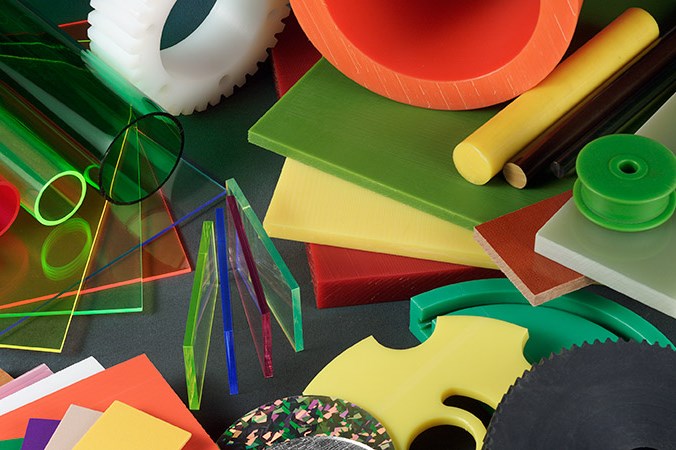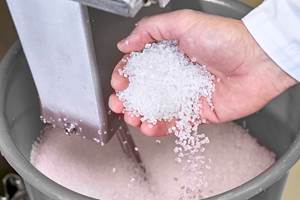Top 10 Modern Trends in Performance Plastics
Curbell Plastics’ senior ด๓ฯ๓ดซรฝ development director weighs in.
We recently heard from Dr. Keith Hechtel, senior director of ด๓ฯ๓ดซรฝ development at .--a leading supplier of plastic sheets, rods, tubes, films, tapes, adhesivies, sealants and prototyping materials, on what he considers to be 10 major trends in performance plastics these days. With headquarters in Orchard Park, N.Y., and locations across the U.S, Curbell offers custom fabrication and next-day delivery of high-quality plastics nationwide. Its customers include small ด๓ฯ๓ดซรฝes, large Fortune 500 companies, government agencies and military organizations. Industries served range from medical device manufacturers to machine shops.
Curbell Plastics customers often need advice that straddles the intersection of materials technology, ด๓ฯ๓ดซรฝ strategy, and hard science and Keith is someone that can focus on those needs. A nationally recognized authority on performance plastics, with degrees in geology, industrial technology, and ด๓ฯ๓ดซรฝ administration, plus more than 30 years of plastics industry experience, Keith leads the Curbell Plastics Business Development team and offers a unique and practical perspective to plastic material selection and application counseling. He has helped hundreds of ด๓ฯ๓ดซรฝes achieve quality improvements and cost savings through the use of performance plastics. He works closely with design and engineering teams to identify plastics that can act as lightweight, cost-effective replacements for metal, glass, and other materials.
Passionate about education, mentorship, and professional development, Keith has trained many of his Curbell Plastics colleagues company-wide on material properties and manufacturing processes, and he is a former college adjunct instructor on ด๓ฯ๓ดซรฝ communication and organizational leadership.

Noting that plastics are now being used to improve quality and safety, and lower manufacturing costs and production time in a wide range of industries including transportation, recreational equipment, medical devices, and many others. Among today’s growing trends in the use of performance plastics, Keith zeroes in on 10 such trends that span industries and applications.
&ฒิฒ๚ฒ๕ฑ่;โช&ฒิฒ๚ฒ๕ฑ่; Specifying Plastics with Antimicrobial Properties and Enhanced Disinfectant Compatibility.
Following the pandemic, surfaces are now being cleaned and disinfected in ways and frequencies that can quickly degrade traditional plastic materials. New antimicrobial and disinfectant-compatible plastics originally developed for use in hospital equipment are now being specified for many nonmedical applications including aerospace interiors, emergency vehicles, and retail store fixtures.
&ฒิฒ๚ฒ๕ฑ่;โช&ฒิฒ๚ฒ๕ฑ่; Using Transparent Plastics to Create Safer Public Buildings. Governments around the world are focused on the need to protect citizens in public spaces. The plastics industry has responded with new classes of transparent polymer sheet materials that can resist projectiles and forced entry. These plastics can be used as monolithic glazing or they can be combined with glass and/or other polymers for enhanced levels of protection. Many of these materials are available with scratch-resistant coatings and UV stabilizers for extended service life.
&ฒิฒ๚ฒ๕ฑ่;โช&ฒิฒ๚ฒ๕ฑ่; Using Innovative Plastics for Orthotics and Prosthetics to Improve Patient Outcomes.
There have been dramatic advancements in the plastic materials used for splints, braces, and artificial limbs. New polymer formulations allow healthcare professionals to craft thinner, lighter, more comfortable devices that maximize patient comfort. These polymers are capable of being shaped using only hot water or a hand-held heat gun instead of an industrial forming oven. This allows adjustments for fit to be made in a medical office, reducing the time that it takes to fabricate and custom-fit a device
&ฒิฒ๚ฒ๕ฑ่;โช&ฒิฒ๚ฒ๕ฑ่; Using Detectable Plastics to Enhance Food Safety.
Engineering plastics offer a number of advantages for food processing machinery including reduced operating noise, low friction, and resistance to cleaning chemicals. However, in recent years there has been growing concern that worn or damaged plastic machinery parts could potentially pass through food inspection equipment, resulting in contamination and costly product recalls. New plastics have been formulated which can be detected by a variety of food-safety technologies including X-ray detection, metal detection, and visual inspection methods.
&ฒิฒ๚ฒ๕ฑ่;โช&ฒิฒ๚ฒ๕ฑ่; Replacing Wood with Plastics to Extend Service Life.
Wood can quickly rot and degrade in outdoor conditions. This results in short part life, reduced aesthetics, and hazards from splinters. Many products traditionally made from wood such as highchairs, outdoor furniture, playground toys, and boat cabin interiors are now being manufactured from highly engineered polyethylene sheet materials. Polyethylene can be formulated to resist weathering and FDA compliant grades can be used in direct contact with food.Polyethylene sheet is available in a wide variety of colors and can be fabricated using ordinary woodworking equipment. It does not rot or splinter and never requires painting.
&ฒิฒ๚ฒ๕ฑ่;โช&ฒิฒ๚ฒ๕ฑ่; Using Polymers to Reduce Weight and Enhance Fuel Efficiency in Vehicles.
Growing concern over carbon emissions and the desire to develop more fuel-efficient vehicles has resulted in increased use of engineering plastics to save weight. Lightweight, durable polymers are being more widely used in passenger railcars, fixed wing and rotary aircraft, and all types of ground vehicles. Many plastics are available in UV resistant formulations for longer service life outdoors. The plastics used in gasoline and diesel-powered vehicles can be formulated to operate in contact with fuels and lubricants. Reinforced high temperature plastics are used in applications where parts are placed in close proximity to engines.
&ฒิฒ๚ฒ๕ฑ่;โช&ฒิฒ๚ฒ๕ฑ่; Replacing Metals and Thermoset Composites with Reinforced Thermoplastics.
Devices that require high strength and stiffness have traditionally been made from either metals or thermoset composites – which have significant limitations. Metals are heavy, which limits their use for applications where light weight is desired. Thermoset composites tend to be brittle and often have poor chemical resistance. Thermoset manufacturing also tends to be slow and labor-intensive. A new class of thermoplastic composites is at the cutting-edge of materials technology. These materials have strength and modulus values comparable to metals and thermoset composites. They also provide many of the advantages of thermoplastics including ductility, superior chemical resistance and the ability to be quickly formed from sheet using heated metal tooling
&ฒิฒ๚ฒ๕ฑ่;โช&ฒิฒ๚ฒ๕ฑ่; Specifying Plastics that Don’t Interfere with Communications Equipment RF Signals.
The proliferation of connected devices and the introduction of 5G telecommunications has resulted in increased demand for high-performance antennas. Optimum antenna functionality requires plastic radome materials that won’t significantly attenuate radio frequency (RF) signals at the operating frequency. Specialized engineering plastics with low dielectric constants and low dissipation factors as well as enhanced toughness, UV resistance, and thermoformability have seen increasing use as protective antenna radomes.
&ฒิฒ๚ฒ๕ฑ่;โช&ฒิฒ๚ฒ๕ฑ่; Using Low-Friction, Long-Wearing Plastics to Eliminate the Requirement for Lubrication.
The machinery used for manufacturing items such as semiconductors, food products, and pharmaceuticals must be maintained at the highest levels of cleanliness. Liquid lubricants such as oil or grease are a potential source of contamination and their use is avoided by these industries to the greatest extent possible. When machinery parts have to move in relative motion to each other, engineering plastics formulated to have low friction and long wear life without the use of external lubrication are often specified.
&ฒิฒ๚ฒ๕ฑ่;โช&ฒิฒ๚ฒ๕ฑ่; Specifying High-Impact Plastics for Durability.
Traditional plastic materials often fail due to brittle cracking, especially when plastic parts are exposed to elevated temperatures or UV light, or when they are dropped or impacted in cold environments. Recent advances include the development of tougher, more impact-resistant plastic materials that remain ductile even after many years of outdoor exposure or when used at extreme temperatures. These materials are being specified for a wide range of applications including heavy equipment bodies, medical device housings, and aerospace interior components.
Related Content
Prices Up for All Volume Resins
First quarter was ending up with upward pricing, primarily due to higher feedstock costs and not supply/demand fundamentals.
Read MorePrices for PE, PS, PVC, PET Trending Flat; PP to Drop
Despite price increase nominations going into second quarter, it appeared there was potential for generally flat pricing with the exception of a major downward correction for PP.
Read MorePolymer Showdown — PC/ABS vs. PC/PBT — May the Best Material Win
First in a series, experts from plastics engineering consultancy The Madison Group will pit leading thermoplastics against each other to see how they differ in processing characteristics, chemical resistance, thermal and mechanical performance, and more.
Read MoreLet's Take a Journey into the World of Molding Thermosets – Part 1
There are many fundamental differences between thermosets and thermoplastics, from the way raw materials are furnished to the molder and the process in which parts are molded.
Read MoreRead Next
Making the Circular Economy a Reality
Driven by brand owner demands and new worldwide legislation, the entire supply chain is working toward the shift to circularity, with some evidence the circular economy has already begun.
Read MoreLead the Conversation, Change the Conversation
Coverage of single-use plastics can be both misleading and demoralizing. Here are 10 tips for changing the perception of the plastics industry at your company and in your community.
Read More












